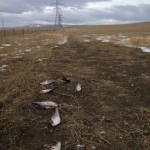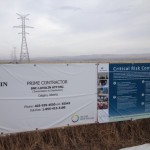By Simmons, Garrett on February 16, 2014.
Group mounts letter campaign over GoldenKey plans
Judy Westcott
For the herald
Concerned citizens gathered for a letter writing campaign Saturday in hopes of sending a strong message to government and industry officials that oil well drilling should not be allowed within the municipal boundaries of the City of Lethbridge.
Held at McKillop United Church, the campaign was organized by The Black Spots, a local citizen group that formed recently in response to a proposal by Goldenkey Oil to seek permission from the Alberta Energy Regulator (AER) to drill three oil wells on privately-owned land in West Lethbridge. The City of Lethbridge has no jurisdiction over oil and gas drilling within its urban boundaries. Drilling approvals are exclusively within the jurisdiction of the AER and public consultations are not mandatory.
“This letter campaign allows citizens to come together and discuss their concerns,” says Sharon Prenevost, a spokesperson for The Black Spots. “It can also provide a little comfort and hope to citizens who are feeling completely hopeless about the situation.”
She says the proposal by Goldenkey Oil to drill three sour wells within the urban boundaries of the city has “touched a nerve” in the community.
“The government tells us not to worry, but we do because of the many issues that have arisen due to fracking procedures over the years,” Prenevost says. “We want to have buffer zones created around urban areas, not just in Lethbridge, but all over the country.”
Residents attending the letter writing campaign were provided with information on mineral rights and drilling procedures, the political process involved in the approval of drilling applications and news articles for background information.
“We’re trying to sort fact from fiction, but when it comes to fracking, it’s very difficult,” Prenevost says. “Companies regard certain information, like what chemical cocktails they are using, as industry secrets.”
Prenevost says that although Saturday’s event was organized by The Black Spots, they were supported by other local groups such as the No Drilling Lethbridge movement and the Mission and Social Action Committee of McKillop United Church, which compiled a list of concerns for letter writers to reference as well as hosting the event.
Some of the concerns being raised include public safety from air emissions, possible water and soil contamination, an increase in the use of residential roads by industrial vehicles, noise and light pollution and the transportation of hazardous materials through residential neighborhoods and high traffic roadways.
Prenevost says a major concern for many residents is the lack of an emergency response plan for the evacuation of the 33,000 residents of West Lethbridge if required.
“In 2012, a disaster scale grass fire fueled by high winds made us very aware of the challenges facing an evacuation,” she says.
Letter writers were encouraged to address their concerns to Alberta Premier Alison Redford, the AER, Goldenkey Oil, local MLAs, members of the Opposition Parties, the provincial ministers for the Environment, Energy, Health and Transporation and the mayor and council of the City of Lethbridge.
Besides the letter writing campaign, The Black Spots have been holding public demonstrations throughout the city and have been circulating a petition to have urban drilling banned.
She says the group will continue to raise awareness of the issue and are looking for inspiration from other interest groups, such as the Knitting Nannies of Australia.
“We’re just a group of concerned citizens who feel we have to take action,” Prenevost says.
“This is an issue that affects all of us.”
![]()

